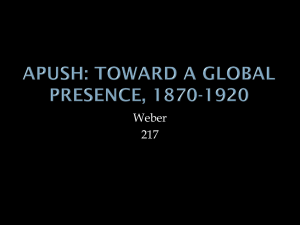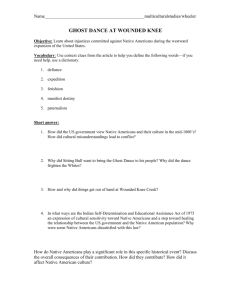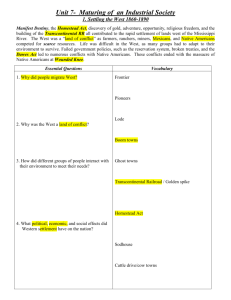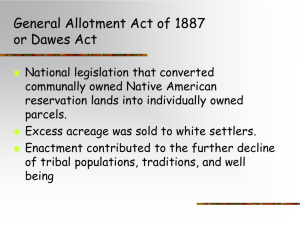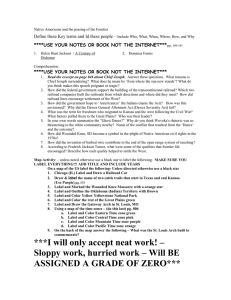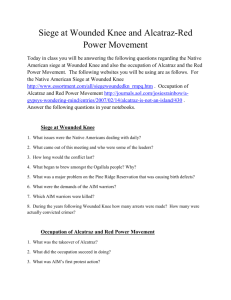APUSH
advertisement
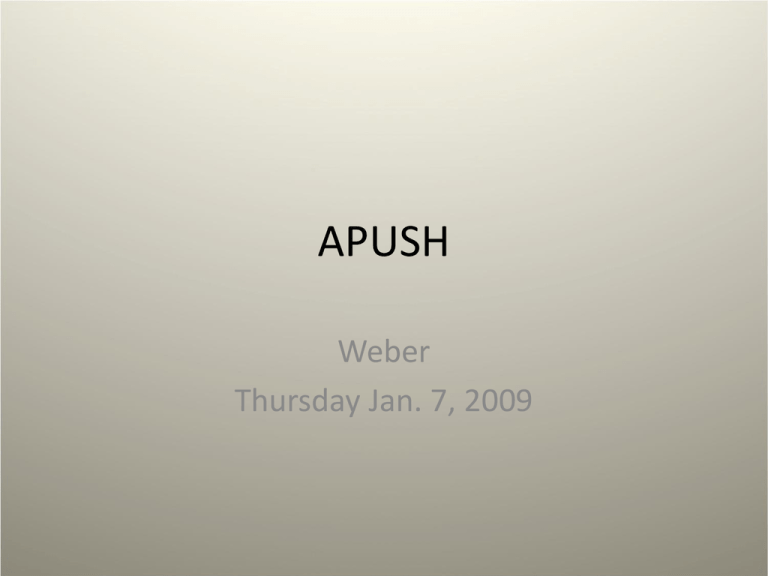
APUSH Weber Thursday Jan. 7, 2009 Activator • What does “assimilation” mean to you? • What does it mean to be “American” or to be “Americanized?” • What were the consequences of westward expansion during the “Gilded Age” for Native Americans? Agenda • Activator, agenda, and objective (10 minutes) • Consequences of Expansion for Native Americans Lecture (20 minutes) • Post-Bellum Expansion Comprehension Check (10-15 minutes) • Bury My Heart at Wounded Knee video clip (10 minutes) • Reflection (10 minutes) • Primary Source Analysis Project (45 minutes) • Homework (5 minutes) Objective • All students will… • Understand the consequences of westward expansion for Native Americans during the socalled “Gilded Age” and tackle issues of assimilation and “Americanization.” • Read ch. 16 in order to learn about the economic developments during the “second industrial revolution” of the late 19th c. Unit 4: Toward a Global Presence • AP Topic #15. Industrial America in the Late Nineteenth Century – Corporate consolidation of industry – Effects of technological development on the worker and workplace – Labor and unions – National politics and influence of corporate power – Migration and immigration: the changing face of the nation – Proponents and opponents of the new order, e.g., Social Darwinism and Social Gospel Remaking Indian Life • In 1877 Congress eliminated a treaty system that dated back to the revolutionary era. • Forced assimilation, trying to make Native Americans “act white” like so-called “civilized” Europeans. • Assimilation provided legitimacy for the racist ideology of Manifest Destiny because many white Americans could tell themselves that they were somehow “doing the Natives a favor” by bringing progress and European ways to them (and therefore justifying stealing their land). Let Me Be a Free Man • The Nez Perce were chased over 1,700 miles before surrendering in 1877. • Chief Joseph spoke of freedom before a distinguished audience in 1879. • Defending their land, Sioux and Chyenne warriors attacked General Custer at Little Bighorn. • These events, however, only delayed the onward march of white soldiers, settlers, and prospectors. The Dawes Act and Indian Citizenship • The crucial step in attacking “tribalism” came in 1887 when the Dawes Act was passed. • The policy was a disaster for the Indians. • Many laws only offered citizenship to Native Americans if they gave up tribal affiliations and assimilated, but the vast majority did not want to give up their identity and culture. • Elk v. Wilkins (1884) made it so that the 14th and 15th did not apply to Native Americans. The Ghost Dance and Wounded Knee • Some Native Americans sought solace in the Ghost Dance, a religious revitalization campaign reminiscent of the pan-Indian movements led by earlier prophets like Tenskwatawa. • On Dec. 29, 1890, soldiers opened fire on ghost dancers encamped on Wounded Knee Creek in South Dakota, killing 200 Native Americans, mostly women and children. Post-Bellum Westward Expansion • The Transformation of the West, pp.601-615 • Landmarks in Indian Relations, 1876-1890 Event Date Battle of Little Bighorn 1876 Chief Joseph’s trek toward freedom 1877 Dawes Act 1887 Battle at Wounded Knee 1890 Outcome Bury My Heart At Wounded Knee Reflection • Write an open response reflection about westward expansion after the Civil War and the consequences for Native Americans • Try to incorporate as many specifics as possible (Dawes Act, Wounded Knee, etc). Primary Source Analysis Project • • In groups of 2-3, pick one of the primary sources about Indian removal and prepare to teach a 5 minute lesson to the class tomorrow Fri. 1/8 Be sure to draw on research from the book or the internet and use APPARTS or the 5A’s (or at least consider the following): • • – Author (who wrote it) – Time period (when was it written) – Audience (who is it written to; who is the intended audience) – Argument (what is the main idea) – Assumptions (what are the underlying assumptions) • • Primary sources on Indian Removal: 1. Tecumseh’s Speech to the Osages (1811-1812) 2. Two Documents on Cherokee Removal (1829 and 1830) – Cherokee Nation “Memorial of the Cherokee Indians” (1829) – Lewis Ross Address of the Committee and Council of the Cherokee Nation… • • 3. Black Hawk’s Surrender Speech (1832) 4. John G. Burnett “The Cherokee Removal Through the Eyes of a Private Soldier” (1890) 5. Two Statements by Chief Joseph of the Nez Perce (1877 and 1879) – Chief Joseph’s Surrender (1877) – Chief Joseph Recounts His Trip to Washington, D.C. (1879) • 6. Black Elk “The End of the Dream” (1932) Exit Ticket and Homework • Exit ticket: What do you think are the modern forces of assimilation or trying to get people to change the way they behave to fit in or to reject part of their culture? Can you give examples? How do they work? • Homework: – Prepare a 5 minute lesson to teach the class about the primary source you selected. – Read Ch. 16 for Tuesday.
